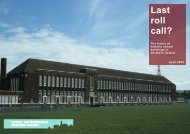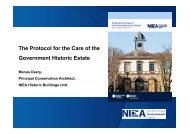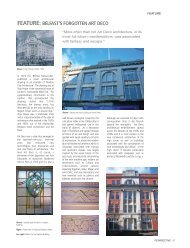Directory of Traditional Building Skills - Mourne Heritage Trust
Directory of Traditional Building Skills - Mourne Heritage Trust
Directory of Traditional Building Skills - Mourne Heritage Trust
You also want an ePaper? Increase the reach of your titles
YUMPU automatically turns print PDFs into web optimized ePapers that Google loves.
Ro<strong>of</strong>s, Chimneys and Rainwater DisposalEnsuring effective rainwater disposal is a crucial part <strong>of</strong> good maintenance. Water should berapidly channelled away from ro<strong>of</strong>s or other surfaces so that there is no risk <strong>of</strong> unwantedmoisture penetrating the structure. It is also essential that there is a satisfactory means <strong>of</strong> takingwater away from the base <strong>of</strong> the building so that it does not affect foundations or cause decaythrough excessive ‘splash back’ onto the walls.Ro<strong>of</strong> coverings are <strong>of</strong>ten attractive as well as functional elements <strong>of</strong> a building. Whereverpossible traditional materials should be used for re-covering ro<strong>of</strong>s. This should apply not onlyto slates and tiles, where natural/handmade types are greatly preferable, but also to thatchwhich should be appropriate to the locality in terms <strong>of</strong> material and detail. Slipped slates andtiles, copings to gable ends and the gradual decay <strong>of</strong> thatch should all be watched and remedialaction taken when necessary.The condition <strong>of</strong> gutters and downpipes should be regularly monitored; occasional inspectionsduring heavy rain showers can be a revealing way <strong>of</strong> seeing how the rainwater goods cope withwater from the ro<strong>of</strong>. At other times stained masonry is likely to indicate that there is a defect<strong>of</strong> some kind such as a blockage or crack. At regular intervals – ideally in the Spring andAutumn – leaves and other obstructions should be cleared. Heavy snow can also causeblockages and flooding as it melts – if this is <strong>of</strong> particular concern snow boards or other modernalternatives can be used to guard against potential blockages. Also to be considered is thecondition <strong>of</strong> lead flashings to chimneys and junctions and other leadwork, such as to valley orparapet gutters and to door canopies or bay windows. Leadwork will not last indefinitely andultimately will need to be repaired or replaced. The involvement <strong>of</strong> a specialist is thenadvisable.MasonryThe masonry <strong>of</strong> a building is not merely the structural material linking the building’sarchitectural features; the type <strong>of</strong> material used and its treatment are essential parts <strong>of</strong> thebuilding’s character. <strong>Traditional</strong>ly there was, in general, an intention to create a unity in thesurface <strong>of</strong> the wall rather than to emphasise the presence <strong>of</strong> bricks or stones in the construction.Thus modern ‘ribbon’ pointing, which creates mortar joints raised from the surface <strong>of</strong> themasonry, is almost always inappropriate for an old building. Rubble stonework was very <strong>of</strong>tenunified by a coating <strong>of</strong> render and/or limewash. Where used, traditional specialist techniques,such as tuck pointing – where the irregularities <strong>of</strong> the bricks are first disguised by a mortar thatmatches their colour, and then this mortar is scored with a narrow line which is itself pointedto produce the appearance <strong>of</strong> a neat and slim joint – should be respected as an essential part <strong>of</strong>the character <strong>of</strong> the brick wall.Regular checks should be made on the condition <strong>of</strong> the masonry and mortar joints. The mortar,traditionally lime-based in most cases, should be s<strong>of</strong>ter than the surrounding masonry. As suchit is intended to be a ‘sacrificial’ element <strong>of</strong> the building where erosion will occur. It is usuallyfelt that re-pointing is required when the depth <strong>of</strong> recession exceeds the width <strong>of</strong> the joint. Thegrowth <strong>of</strong> vegetation near to and within the masonry also needs to be controlled as damage mayresult.XII











